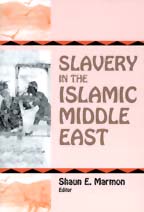 Slavery, recognized and regulated by Islamic law, was an integral part of Muslim societies in the Middle East well into modern times. Recruited from the “Abode of War” by means of trade or warfare, slaves began their lives in the Islamic world as deracinated outsiders, described by Muslim jurists as being in a state like death, awaiting resurrection and rebirth through manumission. Many of these slaves were manumitted and some rose to prominence as soldiers and political leaders.
Slavery, recognized and regulated by Islamic law, was an integral part of Muslim societies in the Middle East well into modern times. Recruited from the “Abode of War” by means of trade or warfare, slaves began their lives in the Islamic world as deracinated outsiders, described by Muslim jurists as being in a state like death, awaiting resurrection and rebirth through manumission. Many of these slaves were manumitted and some rose to prominence as soldiers and political leaders.
Others were not so fortunate. Slaves of African origin, in particular, were often condemned to lives of menial labor. This volume examines the institution of slavery in Islam in a range of cultural settings. Shaun Marmon examines the role of domestic slavery and clientage in Medieval Egypt. Yvonne Seng discusses the social and spatial mobility provided by the institution of slavery in Ottoman Anatolia. John Hunwick examines the debates that took place among the North African ulama in the sixteenth through nineteenth centuries about the relationship between skin color and slavery. Michel Le Gall’s partial translation of memoirs of the French physician Louis Frank presents a vivid picture of the fate of these African victims of the slave trade in the nineteenth century. David Ayalon returns again to the important institution of military slavery in Islam in the pre-modern period.
